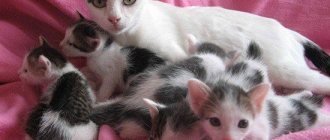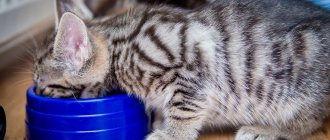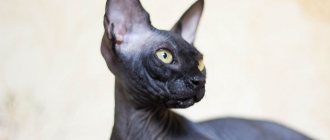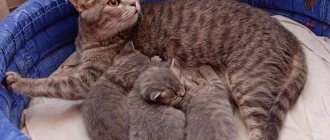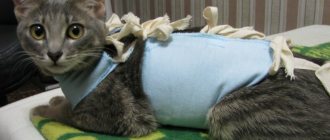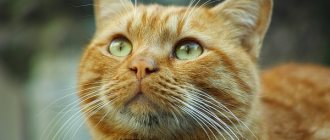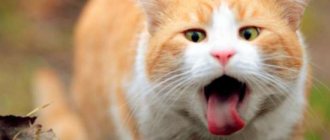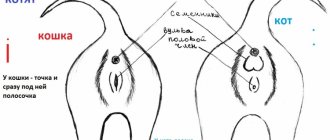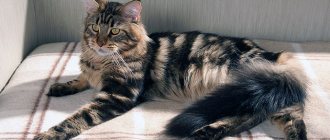To organize proper and complete care for animals, it is necessary to take into account their physiological characteristics in each period of growth. This will allow you to organize competent care, determine the timing of mating, and create a correct and complete diet. Let's figure out what age cats grow to and determine the factors that influence this process.
What is physiological growth
Physiological growth is the process of increasing body size and gaining muscle mass through continuous cell division. The answer to the question of how old cats grow is very ambiguous. The animal grows to the size required by its genetics and breed. For each age, there are certain norms for body size and weight, but there are also individual characteristics. Some physiological and external factors also influence the growth of animals.
In parallel with growth, the development of the cat’s body occurs, the formation and formation of all organs and systems. It is believed that furry pets grow and develop until puberty. Then, this process continues, but not so actively.
Up to what age and how do cats grow?
To organize proper and complete care for animals, it is necessary to take into account their physiological characteristics in each period of growth. This will allow you to organize competent care, determine the timing of mating, and create a correct and complete diet. Let's figure out what age cats grow to and determine the factors that influence this process.
Factors influencing the growth and development of a kitten
The main role in regulating body functions (including growth function) belongs to the endocrine system, namely the pituitary gland. The anterior lobe of the pituitary gland produces the growth hormone somatotropin. This biologically active substance ensures the growth of bones and cartilage, and takes part in the formation of muscle mass. No less important is the general hormonal background, which is created by the work of the thyroid gland, reproductive system and adrenal cortex.
There are several other physiological factors that shape the body’s ability to actively grow:
- Breed characteristics. Cats of small breeds go through physical development somewhat faster than their large relatives.
- Belonging to one gender or the other. Males gain weight more actively.
- Hereditary characteristics. The kitten adopts its character and growth characteristics from its parents. You can understand what an animal will be like at the peak of its development by looking at its mother and father.
The rate of physiological growth of cats is greatly influenced by the external circumstances and conditions in which they live and are raised, as well as the characteristics of their care:
- Habitat. If kittens grew up in a cold climate, with few sunny days, then their metabolism was slowed down. This means that they will lag behind in development from their relatives, who have lived their entire lives in the south.
- Lifestyle. Domestic cats living in warm conditions, receiving enough food and all the nutrients they need, have good immunity and develop faster than street animals.
- Amount of sleep and rest. The cat needs to sleep enough time. If in childhood animals are playful and active, then in adulthood the normal amount of sleep for them should be 17-20 hours a day.
- Physical activity also plays a role in development. The animal must be given enough space and opportunities to play.
- Hereditary and acquired diseases. Owners must take all measures to protect their pets from possible infections. In this sense, the importance of preventive vaccinations cannot be overestimated.
- Early castration and sterilization significantly pushes the limit of active growth. After surgery, the rate of growth and weight gain decreases significantly.
- Early pregnancy has a similar effect. After its onset, the priority for the body becomes bearing and then feeding the offspring.
What can I do to make my cat get better?
First of all, understand the reasons for thinness. If the animal is healthy, you should pay attention to the diet.
On natural food
You should not feed your pet fatty foods. It will contribute to the increase in adipose tissue, which will make the cat bigger and heavier, but will be a colossal burden on the liver. A pet will gain weight faster and without risk to health when there is a lot of meat in its diet, and feeding will be carried out in small portions, several times a day.
To build muscle mass, you need proteins - animal and vegetable. For this purpose, it is recommended to give the cat:
- beef and offal. It is important that the meat is pre-frozen. Before feeding the pet, the product is allowed to thaw to room temperature;
It is recommended to include lean meat (beef) in your cat’s diet.
- cartilage broth;
- chicken meat, preferably breast. Despite all the benefits of chicken, you should not get carried away with it, so as not to provoke an allergy in your cat;
- eggs, preferably quail;
- bran and oatmeal in the form of porridge;
- boiled sea fish, boneless and in moderation;
- cream with less than 10% fat content;
- fermented milk products (kefir, yogurt, cottage cheese), which are also a source of calcium and also contribute to better digestion of food.
For weakened animals, special formulations for enhanced nutrition are recommended, which are sold in veterinary pharmacies in the form of powders and drops.
On the finished core
In this case, everything is much simpler. As a rule, cats that eat premium food look healthy and well-fed. This is explained by the fact that the compositions are perfectly balanced and contain the entire complex of elements necessary for normal nutrition of the cat. Each manufacturer's line includes products for animals that take into account their age, health status and other characteristics.
to navigate the assortment and choose the right food . To do this, you need to know everything about your pet, down to its taste preferences, which will greatly simplify the task. Each food package contains detailed information about the composition of the product, as well as which cats and in what quantity it is best to give the product.
There are a huge number of ready-made cat foods.
As for economy segment feeds, they contain practically no meat. Cats that consume such food for a long time receive insufficient nutrition, which may have adverse effects on their health. Those who believe that the problem can be solved by feeding their pet chicken or cutlets are mistaken:
- firstly, food familiar to people is not always suitable for cats;
- secondly, you should strictly adhere to the chosen nutrition system. That is, you cannot feed the animal both “dry” and “natural” at the same time.
A cat's digestive system adapts to process certain types of food. Thus, dry food is digested easily and quickly, while natural food takes longer to digest. The combination of elements of both nutritional systems threatens serious eating disorders.
You can read more about what is best to feed a kitten: natural products or ready-made dry food here.
Stages of growing up
Growth limits for each animal are individual, but there are averages. It is known that the phase of most active development ends at the age of 10-15 months. Large breeds such as Britons continue to grow for some time after puberty. Small and medium breeds finish their development earlier. These include, for example, fold-eared and straight-eared Scots (medium breeds), and among small ones - munchkins.
There are several main stages of kitten development (starting from birth). In order for the baby to develop correctly and be in good health, it is important that favorable conditions are created for him at each stage:
- The neonatal period (lasts 4-7 days after birth) is a phase of continuous growth, although it is possible that the kitten will lose some weight during this period.
- The suckling period (lasts 3-3.5 weeks). Rapid weight gain phase. Kittens are rapidly increasing in size and learning to navigate independently.
- Transitional period (lasts from 4 weeks to 2 months). The first teeth appear. At this age, complementary feeding and transition to independent feeding are carried out. There is a significant leap in development.
- Adolescence (lasts until the end of active development). Phase of active and uniform growth. This is the period of formation of the skeletal and endocrine systems. It is important that the diet at this time is of high quality and complete.
Active formation of the bone apparatus lasts up to six months. For proper bone growth, the kitten must receive sufficient amounts of calcium and vitamin D during this period.
Cats stop growing by the age of 3, and cats already look like adult animals at 2 years of age. At this time, their ovaries activate. After the bone skeleton and muscle corset have completed their formation, an increase in body weight and size occurs only due to the accumulation of fat.
How to choose a kitten that will grow large?
First, you need to find a breeder of large-breed animals with extensive experience and a convincing reputation in order to purchase a suitable kitten from him. The animal must:
- be a purebred representative of your breed, which would be confirmed by metrics;
- have good health and vaccinations according to age. Notes about this should be looked for in veterinary documents;
- be at least two months old. Experts believe that for full development, a kitten must feed on mother’s milk up to this age;
It is advisable to choose a male animal, ideally the largest in the litter. It is worth paying attention to parents. Not all large breeds grow large and heavy. Heredity in this matter is one of the determining factors.
When choosing a kitten, the future owner's eyes widen
Then everything is simple. You should take proper care of your pet and feed it well, not allow it to wander on its own, and also contact the clinic in a timely manner if your pet gets sick.
Providing ideal conditions for development
The first five months of a kitten's life are especially important. This period determines how actively and qualitatively their future life will be. The owner must do everything to ensure that the development of the small organism proceeds correctly. Proper care is of great importance. During this period, the conditions in which kittens grow must be ideal:
- Stable air temperature (about 20 degrees Celsius) and humidity (about 55%).
- Maintaining hygiene. The cat's nest should be cleaned regularly. At the bottom there should be a special bedding that absorbs urine, liquid feces and traps pathogens.
- Protection from parasites. The first deworming should be done at the age of 8 months. Constant protection against skin parasites, fleas and ticks is also important.
- When transferring to independent feeding, it is necessary to ensure that the kitten’s diet is rich in vitamins and balanced in the amount of nutrients and microelements.
Reasons for slow growth in kittens
There are several reasons why the active growth and development of kittens in the first important year of life can be significantly slowed down. Here are the main ones:
- Insufficient or inadequate nutrition. In the first months of life, the kitten may not have enough mother's milk. When transferred to independent feeding, he may suffer from a monotonous and incorrectly selected diet, poor in vitamins and minerals.
- Hereditary deviations. If the kitten’s parents suffered from genetic pathologies, then the likelihood that they will be passed on to the baby is very high. Correcting such deviations is difficult, and in many cases it is not possible.
- Hormonal imbalances. The main cause of hormonal imbalance at a young age is early sterilization or castration. Usually, the body of a kitten that has survived such an operation stops developing for some time. Over time, this process is restored.
- Viral and infectious diseases. An infectious disease often causes complications in the stomach or intestines. This affects the absorption of food and microelements necessary for growth.
- Helminthic infestations. Parasites take away a significant portion of the nutrients that come from food, so even with a good appetite, the baby becomes thin and slows down its growth. Preventive quarterly deworming is a salvation.
Why is my pet growing slowly?
To understand how long kittens grow, you need to pay attention to their lifestyle. There are many different factors that cause animal growth to slow down.
There are many reasons for a cat's slow growth
Care and habitat
Living conditions are very important for the development of a pet. Outdoor cats suffer significantly in development due to lack of proper care. This happens due to vitamin deficiency and weakened immunity.
Hormonal imbalance
Hormonal imbalances can slow down the development of an animal, but after some time it can begin to grow rapidly again. This is especially true for castrated males.
Presence of parasites in the body
If a kitten has worms, this will inevitably lead to slower growth. Worm infestations are dangerous for any pet of any age. The animal may even die.
Taking hormonal medications
Hormonal drugs, despite the prevalence of their use, can have a negative effect on the animal, slowing down its growth and development.
Important! The drugs can have a negative effect on the hormonal levels of purebred cats.
Passive lifestyle
It is known that pets leading a passive lifestyle grow more slowly, and their body may be disproportionate in development.
If a cat moves little, its muscular system stops growing, circulatory processes are disrupted, and concomitant diseases arise, for example, diabetes.
Important! Early mating can negatively affect the development of the pet.
Past viral diseases
Often, lack of weight is a consequence of past illnesses. Infections can affect a kitten’s fragile body, leading to disturbances in the gastrointestinal tract and deterioration in the absorption of substances. Organs do not receive enough nutrients from the blood, growth slows down and weight gain also slows down.
Ways to enhance the growth and development of kittens
A veterinarian will help determine the cause of slow growth and development. If these are endocrine disorders or hormonal imbalances, the doctor may prescribe injections of drugs that normalize metabolism and stimulate accelerated growth. These include kartinina chloride (growth vitamin), Gamavit, Milgamma (vitamin B complex).
A kitten that is lagging in growth and development must be surrounded with care and attention. It has been proven that an animal that is loved, caressed, praised and stroked grows well and gains weight.
Features of growth of large breeds
There are several artificially bred cat breeds, the representatives of which are particularly large in size. The most common of them are the following:
- Maine Coons;
- Bengal breed;
- British breed.
Let's look at the age at which large breed cats grow, and what size they can reach with good care.
Bengal breed
Kittens are born very small, their weight does not exceed 120 grams. During the first month of life, kittens gain weight up to 500 grams. Then active development stops, and by the age of 3 months the weight is a little more than one kilogram. At 7 months the process slows down even more, but continues to progress. Animals gain the bulk of kilograms in the first two years of their existence. Regular cats weigh 7-8 kg at 5 years old, while castrated cats can reach 10 kg.
Maine Coons
The weight of a newborn Maine Coon can be 170 grams. By gaining 10 grams in weight every day, a kitten aged 10 days becomes 2 times heavier, by 28 days - 4 times heavier, and by 8 weeks - 8 times heavier. At the age of 4-5 months, the kitten's peak growth activity occurs. At this time, its energy costs are greatest. Bone growth continues for up to 1.5 years, after which muscle mass develops and the animal grows in breadth. A cat reaches its peak of development at the age of 3-5 years. At this time, his weight can increase to 10 kg.
How tall is the average cat?
The average domestic cat is about 9.5 inches, or 24 centimeters, tall. This figure is derived from all breeds of domestic cats around the world, including feral, farm and domestic cats. Cats not included in this average are wild but related species such as bobcats, lions and jaguars. The average height of cats varies by breed and sex, with females typically being one to two inches shorter than males of the same breed.
How tall is the average male cat?
The average male cat stands on the higher end of the dimensions. Most male cats are about ten inches (25 cm) tall. However, this figure can vary greatly depending on the breed and age of the cat. A male Savannah cat can easily reach 16-17 inches (40-43.4 cm) in height, which is taller than a beagle.
How tall is the average catwoman?
The average height of a female cat is about 9 inches, or 23 cm. Female cats tend to be smaller than males in all domestic cat breeds, usually being one to two inches shorter. Females are also typically two to five pounds lighter than their male counterparts. The female Savannah cat is typically 13 to 15 inches (33.1 to 38.1 cm) tall.
